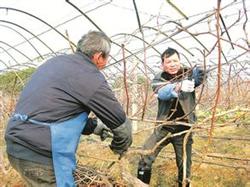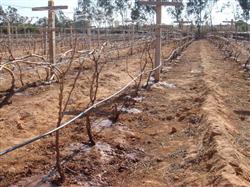Early Fruit cultivation techniques of American Black and Red Grape

First, the garden construction technology: 1. Garden selection: grape is most suitable for sandy loam with loose soil and rich organic matter. two。 Frame type selection: in order to produce early and increase the previous yield, we should choose the hedge type, mainly the single hedge type. Row spacing 2-2.5 m, frame height 2-2.5 m, pillar spacing 4-5 m, 50 cm from the ground on the pillar and 40-50 cm up, one wire each, a total of 4 wires. 3. Planting density: row spacing is 2 meters, plant spacing is 1.5 meters, 330 plants per mu, leaving 3-5 vine pruning. 4. Planting techniques: (1) dig high-yield ditch: before planting, dig a high-yield ditch with a width of 50 cm and a depth of 60 cm. Before backfilling, the ditch is filled with organic fertilizer or straw. (2) planting period: the best planting time of nutrition bag seedlings is early June, and that of hardwood cuttings is late November. (3) planting requirements: first mark the planting point according to the requirements of row spacing, and then dig a planting hole of 30-40 cm square for planting. Nutrition bag seedlings should be planted with strong seedlings with a height of 20-30 cm, strong stems and thick leaves, and the survival rate can reach more than 95%. Using one-year hardwood cuttings, fibrous roots should be selected, and first-class seedlings with full buds from 3-4 households should be planted. While planting, cover the soil while firm, immediately water after planting, and then bury the soil into a small pile. (4) plastic film mulching: the following year, digging soil and releasing seedlings, watering sunny water, and covering plastic film in time are beneficial to increase temperature and preserve soil moisture, promote slow seedlings and start new branches early. Second, tree management: 1. Soil fertilizer and water management: (1) soil management: according to the occurrence of weeds, ploughing and weeding 3-5 times in the whole year, combined with fertilization in autumn, the whole garden will be turned deep once, with a depth of 20 cm, which will help to loosen the soil and promote root growth. (2) fertilization: grapes like fertile and loose soil, and applying more organic fertilizer can effectively increase soil nutrients and improve soil structure, which is an important basis for high quality and high yield. First, the application of base fertilizer in autumn should be early and sufficient. After fruit harvest, the soil is 20 cm deep, with 4000-5000 kg of base fertilizer per mu, and mixed phosphate fertilizer or compound fertilizer. The second is to promote budding fertilizer, before sprouting, ditch application, 10-15 kg urea per mu. The third is to promote fruit fertilizer, after fruit setting, when beans are big, mainly nitrogen and phosphorus, urea and compound fertilizer each 15 kg per mu. Fourth, fruit coloring fertilizer, mainly potassium and phosphorus, 10 kg compound fertilizer per mu. Fifth, foliar topdressing, spraying 0.3% potassium dihydrogen phosphate and adding trace element fertilizer 2. Shaping and pruning: there is no regular fan shape, 3-4 strong shoots are selected to cultivate 3-5 main vines to form a fan, and every 20-25 cm on the main vine in the second year, one fruiting branch group is selected. 3. Summer pruning: (1) wiping buds and thinning branches: in order to reduce the consumption of nutrients, sprouting should be done sooner rather than later. The sprouts of large black grains and red earth are higher, so the remaining branches should be wiped off as soon as possible, leaving only the main buds in the double or three buds, and one strong bud in each node. (2) coring of new shoots and secondary shoots: coring of fruiting branches was generally carried out one week before flowering. Treat the secondary shoot, that is, leave 3-4 leaves at the top of the secondary shoot above the inflorescence, pick the heart repeatedly. (3) pinch ear tip and ear shaping: large black grain and red earth have the characteristics of large ear and large grain. Only the pruned inflorescence can achieve large grain and beautiful spike shape. During the period of rapid inflorescence elongation before flowering, the apical part of inflorescence is pinched off by hand about a week before flowering, accounting for 1 × 5-1 × 3 of inflorescence length, and at the same time, the secondary inflorescence and the first and second branches of inflorescence are removed, so that the inflorescence forms a short garden column, which is beneficial to increase fruit setting rate, increase fruit grain weight, make fruit ear a compact cone, and improve the appearance quality of goods. (4) binding, pruning and picking leaves to improve ventilation and light transmission conditions: during the period from July to August, the branches and leaves of grapes are luxuriant, which is easy to cause depression, so they should be treated as soon as possible. The introduction of new tips is a regular work, which is carried out 3-4 times a year. When the growth of new shoots is too prosperous and there are too many branches and leaves, it is necessary to prune the shoots in time, cut off the first part of overlong branches, and remove weak branches and old leaves, so as to improve ventilation and light transmission conditions. 4. Winter pruning: (1) pruning length of fruiting mother branch: black big grain, red earth grape fruiting mother branch base bud setting rate is higher, using medium and short shoots pruning, production of hedgerow cultivation should be mainly medium and long shoots, with short shoots pruning. (2) Branch group renewal: in order to prevent the outward migration of the fruiting part and ensure the robust fruiting mother branch every year, the double branch renewal method should be chosen, and the outward migration of the fruiting part can be effectively controlled by pruning the preparatory branches every year. Third, disease control: 1. Agricultural prevention and control: strengthen summer pruning, improve shelf ventilation conditions, timely cut off diseased leaves, diseased branches, diseased fruit and burn them. two。 Chemical control: during the growing period, it can be sprayed with Bordeaux solution of 1%, 0.5 and 200 times to prevent downy mildew, and spray 25% metalaxyl 600 times, or Dasheng 600 times during the onset of the disease.
- Prev

Winter pruning technique of grapes in scaffolding
Most of the scaffolding grapes are trimmed by the "keel" method, which can maintain good ventilation and light transmission, strengthen the top advantage, make the tree strong, and achieve the goal of high quality and stable yield. First, it is more appropriate to use a single slope scaffolding for the retention and shearing of the main vine, which is inclined to the south. Munag grape grows more vigorously, according to its.
- Next

Drip Irrigation Technology of Grape in greenhouse
Drip irrigation is the most ideal technology for grape irrigation in greenhouse. It has the advantages of water saving, increasing production, cooling, labor saving and high efficiency. First, simple drip irrigation production: build a storage tank with a capacity of 3-5 cubic meters and a height of 1-3 meters at the head of the shed, install gate valves and water meters at the outlet of the pool, and use 38 mm plastic pipes to make capillary tubes in the shed.
Related
- Moge, come on! The staff of the peasant association in the producing area of cantaloupe were frightened when the crowd gathered.
- Causes and Solutions of low Fruit setting rate of Apple
- Symptoms and control measures of passion fruit virus disease
- Fruit growing lesson: how do apple orchards keep high yields?
- Can you build orchards in the mountains? What are the pros and cons?
- How to manage the coloring period of Crisson grape?
- This paper introduces the processing technology of two kinds of fig products.
- How much is a month for retired teachers in rural areas by 2020?
- How can strawberry planting increase sugar content? We should pay attention to management in many aspects.
- What are the cultivation techniques on how to improve the yield of golden fruit?

